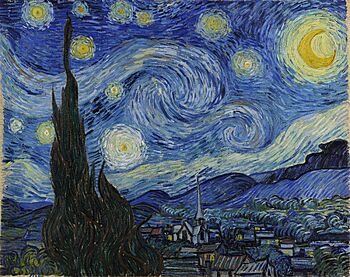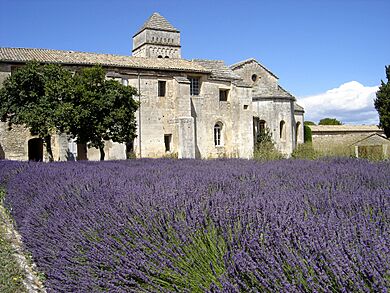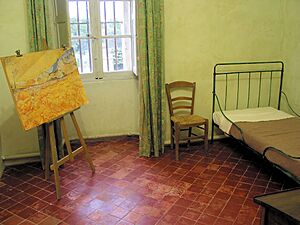The Starry Night facts for kids
Quick facts for kids The Starry Night |
|
|---|---|
 |
|
| Artist | Vincent van Gogh |
| Year | 1889 |
| Catalogue |
|
| Medium | Oil on canvas |
| Dimensions | 73.7 cm × 92.1 cm (29.01 in × 36.26 in) |
| Location | Museum of Modern Art, New York |
| Accession | 472.1941 |
The Starry Night (Dutch: De sterrennacht) is a famous painting by the Dutch artist Vincent van Gogh. He painted it in June 1889 using oil paints on canvas. The painting shows the view from his room at a special hospital in Saint-Rémy-de-Provence, just before the sun came up. He also added a village that he imagined. Since 1941, this painting has been a part of the collection at the Museum of Modern Art in New York City. Many people think The Starry Night is one of Van Gogh's best works and one of the most recognized paintings in the world.
Contents
The Starry Night: A Famous Painting
Van Gogh's Time at the Asylum
After a difficult time in December 1888, Van Gogh decided to go to a place called Saint-Paul-de-Mausole in May 1889. This was a special hospital, once a monastery, where he could get care. It was not very full when he arrived, so he had a bedroom on the second floor and a room downstairs to use as his art studio.
During the year Van Gogh stayed at this hospital in Saint-Rémy-de-Provence, he continued to paint many artworks. He had started painting a lot in Arles before coming here. While at the hospital, he created some of his most well-known paintings. These include Irises from May 1889, which is now at the J. Paul Getty Museum. He also painted a blue self-portrait in September 1889, now at the Musée d'Orsay. The Starry Night was painted around mid-June. On June 18, he wrote to his brother Theo saying he had a new painting of a starry sky.
What the Painting Shows
Even though The Starry Night was painted during the day in Van Gogh's studio, it shows the view from his bedroom window. This window faced east. Van Gogh painted this view many times, at least twenty-one different versions, including The Starry Night. He wrote to his brother Theo around May 23, 1889, saying, "Through the iron-barred window, I can see an enclosed square of wheat ... above which, in the morning, I watch the sun rise in all its glory."
Van Gogh painted this view at different times of the day and in various weather. He showed sunrises, moonrises, sunny days, cloudy days, windy days, and even a rainy day. The hospital staff did not let him paint in his bedroom. However, he could make sketches there using ink or charcoal. He would then use these sketches to create new paintings. In many of these paintings, you can see the low, rolling hills of the Alpilles mountains. In fifteen of his twenty-one paintings of this view, cypress trees are visible. Van Gogh made these trees look much bigger in six of his paintings, especially in Wheat Field with Cypresses and The Starry Night. He brought the trees closer to the front of the painting.
Stars, Moon, and Village
The Starry Night is the only painting in this series that shows a night scene. In early June, Van Gogh wrote to Theo, "This morning I saw the countryside from my window a long time before sunrise with nothing but the morning star, which looked very big." Scientists have found that Venus (often called the "morning star") was indeed very bright and visible at dawn in Provence in the spring of 1889. So, the brightest "star" in the painting, just to the right of the tall cypress tree, is actually Venus.
The Moon in the painting is not exactly how it would have looked in real life. Records show that the Moon was a waning gibbous shape when Van Gogh painted this. Even if it had been a crescent moon, Van Gogh's Moon would not have been scientifically correct. The village in the painting was not visible from Van Gogh's room. He based it on a sketch he made from a hillside above the village of Saint-Rémy. Some experts believe the church steeple in the painting looks more like steeples from Van Gogh's home country, the Netherlands, rather than from France.
How the Painting Was Owned
Van Gogh sent The Starry Night to his brother Theo in Paris on September 28, 1889. Theo passed away less than six months after Vincent, in January 1891. Theo's wife, Jo, then took care of Van Gogh's artworks. In 1900, she sold the painting to a poet named Julien Leclercq in Paris. In 1901, Leclercq sold it to Émile Schuffenecker, an old friend of another artist, Gauguin. Jo later bought the painting back from Schuffenecker. In 1906, she sold it to the Oldenzeel Gallery in Rotterdam. From 1906 to 1938, a woman named Georgette P. van Stolk owned it. She then sold it to an art dealer named Paul Rosenberg. Finally, in 1941, the Museum of Modern Art bought the painting from Rosenberg, and it has been there ever since.
Colors and Materials Used
Scientists at the Rochester Institute of Technology and the Museum of Modern Art have studied The Starry Night. They looked closely at the paints Van Gogh used. Their analysis showed that the sky was painted with ultramarine and cobalt blue pigments. For the bright stars and the Moon, Van Gogh used a special yellow pigment called indian yellow along with zinc yellow.
See also
 In Spanish: La noche estrellada para niños
In Spanish: La noche estrellada para niños
- List of works by Vincent van Gogh
- Baldin Collection
- "Vincent", a 1971 song by Don McLean written as a tribute to Vincent van Gogh
- Timbres, espace, mouvement: an orchestral music piece (1978) by Henri Dutilleux inspired by the painting
Images for kids
-
F1548 Wheatfield, Saint-Rémy de Provence, Morgan Library & Museum














